It has been almost three full years from the time Jim Crane, owner of the Houston Astros, and Mark Lerner, principal owner of the Washington Nationals, met at the request of Palm Beach County, Florida to work together to build a new two-team spring training facility in South Florida.
Since then, Giles Kibbe, the Astros’ General Counsel, and Arthur Fuccillo, Executive Vice President of Lerner Enterprises, have worked tirelessly to make the facility a reality for the fans of the teams and Palm Beach County itself.
Fuccillo, who acted as my host for a tour of the complex, has been at Lerner for over thirty-five years. As such, he has been involved in all facets of legal work, the development of regional malls, major shopping centers, apartment complexes, hotels, the present day Nationals Park and significant other commercial developments.
However, since the Lerner family owns the Washington Nationals (and Fuccillo is a minority owner himself), he is asked from time to time to use his construction/development and legal experience to help in the business dealings of the baseball club. So it was only natural that he was asked to become involved in the zoning, negotiation and construction of the team’s new spring-training complex.
And he is quick to point out that, “as they say, we’re on time and on budget.” That budget, he said, is exactly $148,577,137.
And the timeline is in good hands. “Hunt Construction Group is working around the clock to get us open. They have over 650 people on site,” he added. “We cannot thank our consultants enough for all their hard work and time they have put into this project. We look forward to being here with the Houston Astros and having successful spring training seasons for the next 30 years.”
The parcel of land for this complex measures approximately 160 acres. When you subtract areas for parking, the three lakes within its borders and a ten-acre community park that will be built along its western edge, you’re left with less than 100 acres for the actual practice facilities and stadium. That made it critical to be efficient with the use of land.

While the “glamour” part of spring training happens during the afternoons when exhibition games are played in front of thousands of fans, the heavy lifting happens in the mornings at practice fields like this. This one has dimensions and a playing surface where Major Leaguers will feel at home. It’s one of two on the Nationals’ side of the complex. Beyond its right field is a “cloverleaf” or “quad” of four practice fields that will typically be used by Minor Leaguers.

Mo Stein, Principal and Senior Vice President at HKS (the architects for the complex and its ballpark), told me that the layout of the complex was done with foot traffic in mind. “What you want to be able to do is to move the players efficiently, but you also don’t want the fans to have to walk forever” to get from the parking lots to the stadium. Hence you get wide walkways that radiate out from the ballpark into the practice fields. This is the result of the meticulous planning that went into the site design.

Here you see a walkway that leads from the Nats’ Major League practice fields toward their clubhouse.
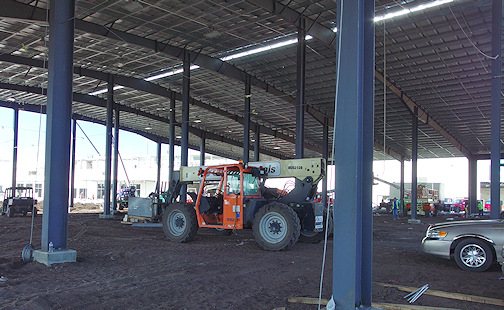
The Astros’ facilities occupy the north side of the complex, while the Nationals are on the southern half. By no means are the two sides laid out in precisely the same way, because each team has its own set of priorities. “It’s impossible to find two teams who do everything the same way,” Stein explained. “When they actually have the opportunity to think about the way they want to work and the way they want to prepare their players, they make decisions that sometimes even surprise themselves.” Some MLB franchises like to mix the Minor Leaguers with the big-league players during spring training, and some want them separated.
The shots above and below show one way in which the Astros and Nationals differ. The Nationals’ batting cages are combined in one huge structure (above) while the Astros preferred to have two smaller structures on either side of an agility field (below). If you look closely, you’ll see the roof for the second building in the background.

Most fans who drive to the exhibition games here will park in the northwest corner of the complex (near the intersection of 45th Street and Haverhill Road in West Palm Beach) or along the southern edge of the property, which is bordered by a canal. Because of the proximity of these southern lots to the canal, this 27-acre area cannot be paved. Therefore, after the Grapefruit League season is over in the spring, these lots will be used as community soccer fields.
Regardless of where you park, you’re likely to enter the baseball stadium on its west side (see below).
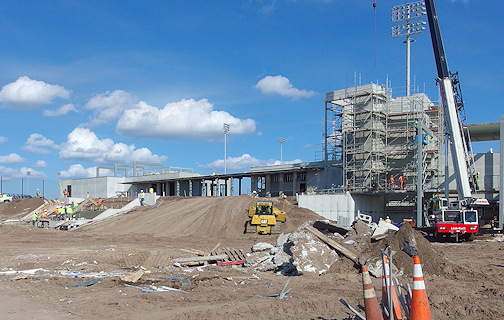
“We designed it to be highly public-accessible,” Stein added. “The entry plaza here is 35,000 square feet. It’s designed so that you could start a 10-K race here or have a community arts fair or any number of things.” That plaza area is shown above. On the left side of the shot you can see concrete is being poured to create stairs.
“That grand stairway goes from the plaza up to the concourse (of the ballpark). Since it’s right along a lake, it’s a beautiful entry feature.” You can see the 13-acre lake in the photo at the top of this page.
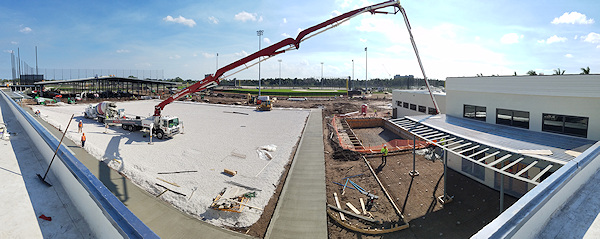
This photo shows concrete being poured for an outdoor swimming pool where a number of training exercises can be done. On the left half of the shot is where the Nationals’ agility field will be located.
The building on the right above is the Nats’ clubhouse, which encompasses a whopping 51,000 square feet.
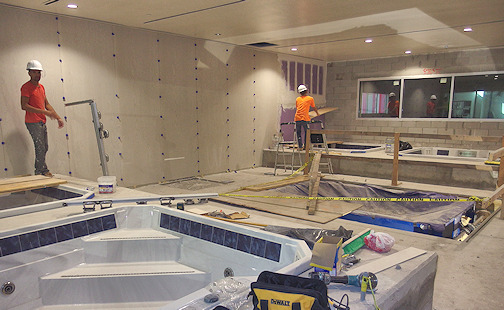
Just inside is the indoor hydro-therapy room. This is an area of training that has become extremely important to Major League teams.
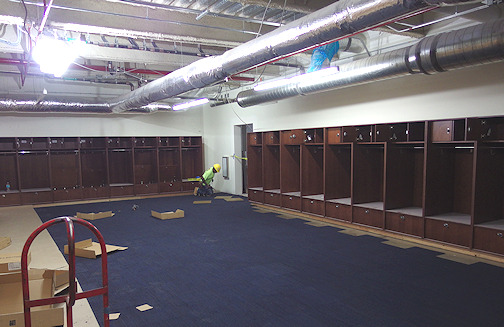
You might assume that these beautiful, solid-wood lockers will belong to the Major League players, but you’d be mistaken. This is the Nationals’ Minor League clubhouse.
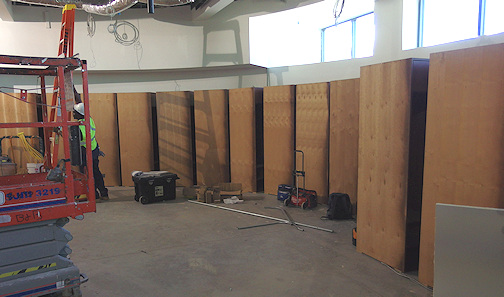
On the day of my tour, the wood lockers for the Major Leaguers were being installed. As is now the custom, the room is a big oval. This one offers a great deal of natural light, too.
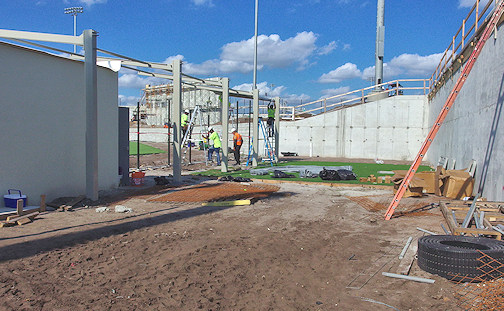
Next are scenes from inside the ballpark itself. This will be the Nationals’ bullpen, or when the Astros are the home team, it will be the visitors’ bullpen. It is just beyond the right-field wall.

This was taken from the right-field corner. As you can see, the warning track is about to be installed.
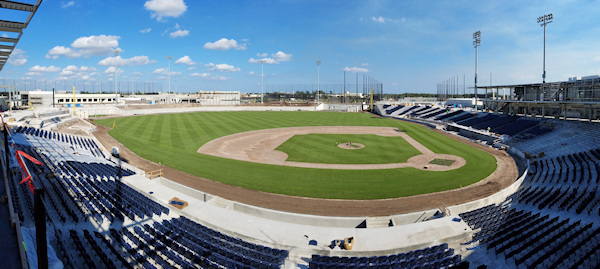
This gives you a good idea of the ballpark’s beauty. It makes great use of shade (there will be much more on that topic in our in-depth review of the park, which will come out after exhibition games start) and the seating bowl offers unparalleled views of the field.
The stadium will feature 6,400 fixed seats and room for another 1,250 on the outfield berms, which is a little smaller than other recently constructed spring-training parks. “It’s really a very intimate feel,” Fuccillo remarked, adding “It’s really a beautiful, beautiful stadium. It gives you a 360-degree optic.”

Seats were still being installed on the day of my visit, although the vast majority were already in place. This shot gives you an idea of the perfect pitch (slope) of the seating bowl.
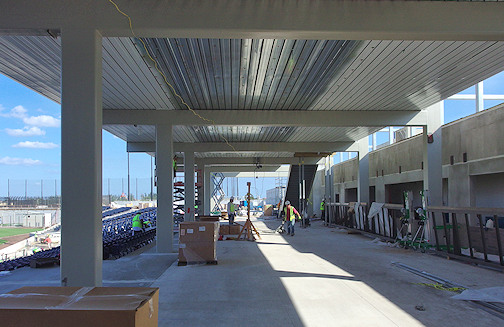
As you can see, the concourses are quite wide and offer a great view of the field. Fans will enjoy having some elbow room in these spaces.
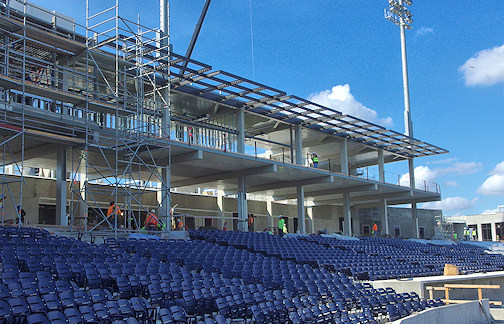
This is taken from the home plate area, looking up toward the upper deck behind third base. Suites will be located here, although fewer of them than you might expect, Fuccillo pointed out. “It was really for the fans’ experience outdoors.”
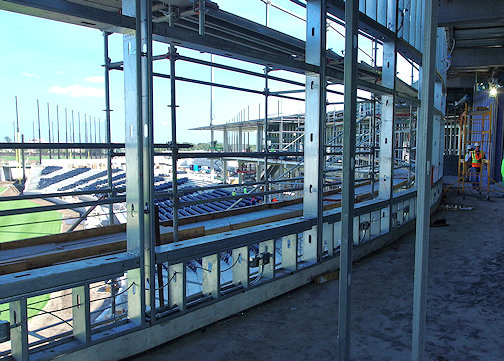
This will be the press box. Writers and broadcasters will have a wonderful view of the proceedings.
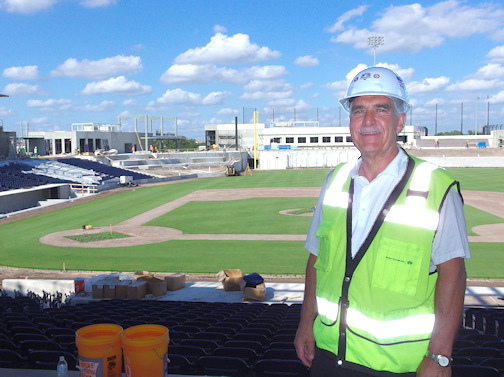
This is Art Fuccillo, my tourguide for the afternoon. He did a great job of not only showing me around, but also of giving me insight into the thinking behind the design decisions.
Indeed, I couldn’t have been more impressed. Work is coming along very well, and I can’t wait to see exhibitions here. As Fuccillo told me, “We play our first game here on February 28th, 1:00 in the afternoon. Everybody is welcome!”
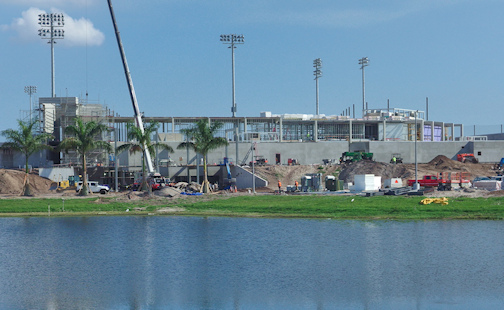
I wonder if they will get this all done in time. It all looks far from finished.
Not to worry. The head of the architecture firm told me that the construction team is hard at work, and that the stadium will be completely ready by the first exhibition game, which is Feb. 28. The player-development part of the complex (clubhouses, practice fields, workout areas, etc.) is already almost done.
A welcome addition to Palm Beach County, giving us four major league teams in this county. As President of an Adult Baseball League, we would be very interested in renting the minor league fields for our spring 2017 season, which will get underway in late March/April. We have been in business for 25 years, 50 seasons, and use baseball fields throughout the county, including four of the St.Louis Cardinals’ complex at the Roger Dean Stadium facility in the spring. Our games are always played on Sunday morning/afternoon. I would appreciate hearing from officials at the Ballpark of the Palm Beaches about the availability of the minor league fields. In addition, I have worked as official scorer/press box announcer for the St. Louis Cardinals since Roger Dean Stadium opened in 1998, and am a public address announcer for Florida State League games, involving the Palm Beach Cardinals and Jupiter Hammerheads.
I may be reached by phone at (561) 358-4532
How much shade is offered for the fans. In other words from the last row toward the field extending from behind home plate toward the bases how many rows are shaded
I won’t be able to answer that until I actually attend a game there in March … however, I do know that a tremendous amount of research was done regarding the orientation of the seating bowl so that the shade would be maximized. And since the 3B foul line runs roughly north-south, more of the 3B stands should be shaded for afternoon games than on the 1B side.